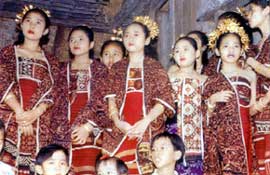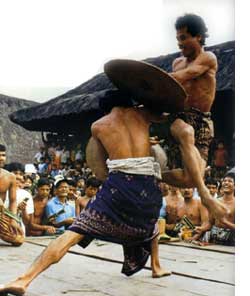 DENPASAR (indo.com): At one time the island of Bali was occupied by a unique ethnic group, the members of which, filed and blackened their teeth. They lived in small communities - family clans ruled by a council of elders who were also priests of their religion, which centered on the worship of powerful forces of nature, and especially those of their ancestors, with whom they continued to live as a great family of both the dead and the living.
DENPASAR (indo.com): At one time the island of Bali was occupied by a unique ethnic group, the members of which, filed and blackened their teeth. They lived in small communities - family clans ruled by a council of elders who were also priests of their religion, which centered on the worship of powerful forces of nature, and especially those of their ancestors, with whom they continued to live as a great family of both the dead and the living.Occasionally, by means of sacrifice, they brought their ancestral spirits down to Earth to protect them. They buried their dead or simply abandoned them in the jungle to be carried away by the spirits, and it is possible that they ate parts of the bodies in order to absorb the magic power inherent in their ancient headmen.
The descendants of these people call themselves Bali Aga, meaning original Balinese. They lived isolated and independent in the mountains where they found refuge from imperialistic invaders. Hidden in the hills of East Bali lies the village of Tenganan, where the most conservative of the Bali Aga preserve the old traditions with the greatest zeal.
Tenganan is an isolated community, socially and economically separated from the rest of Bali. It is shut off from the world by a solid wall that surrounds the entire village. The wall is meant to keep outsiders away, and it is broken by means of four gates, facing north, south, east and west respectively. Within these walls lies a banyan tree surrounded by a low wall of uncut stones, providing the small enclosure for a very sacred temple.
Unlike the rest of the villages in Bali, there is hardly any vegetation around the houses of Tenganan, which are all exactly alike. They are arranged in rows on each side of stone - paved avenues. In the central place is the council house where the elders meet. This council house is some seventy feet long, strongly built and apparently very old. Farther along are other buildings for public use. The dwellings in Tenganan are all exactly the same. A flight of steps leads to a small gate which opens into a court where the sleeping - quarters the kitchen, and a long house for storage are all located. There is also a small empty shrine where the spirits may rest when they visit their descendants.
The people of Tenganan are tall and slender in a rather ghostly way with white skins and refined manners. The majority of the men still wear their hair long. They live in a communistic system in which individual ownership of property is not recognized.The village of Tenganan owns enormous tracts of fertile and well - cultivated lands that fill every need of the village and make it one of the richest in the island of Bali.
Blood sacrifice
Tenganan is one of Bali's most ancient and most unique villages. It is located in the eastern part of Bali, 17 kilometers from Amlapura, the center city of Karangasem Regency, and approximately 65 kilometers drive to the east from Denpasar. Accessible by public transport, car and motorbike, the trip to Tenganan is exhilerating, traversing winding roads through the ranges.
The uniqueness of Tenganan to this day provides a considerable draw card for tourists, foreign and domestic alike, who come to witness the ancient and original Balinese who continue to practice their unique culture to this day. One of the local customs that has been particularly popular among tourists is that of the ritual blood sacrifice; in which all the locals get involved in an annual ritual combat. Using thorny pandan leaves, each combatant hits their opponent with the aim of drawing blood. Locally known as "mekare kare", the ritual fight is held whenever there is a temple ceremony is Tenganan, which tends to fall in the fifth month of the Balinese calendar.
 This duel must be real fighting and of course one of two must injure and draw blood from the other. So all the participants must be well - prepared. They carry weapons including a shield made from woven rotan and a bundle of thorny pandan leaves, which are used to scratch the opponent's skin until bleeding.
This duel must be real fighting and of course one of two must injure and draw blood from the other. So all the participants must be well - prepared. They carry weapons including a shield made from woven rotan and a bundle of thorny pandan leaves, which are used to scratch the opponent's skin until bleeding.Before this ritual duel begins, participants drink rice wine or the local palm known as tuak. In this context, drinking is a symbol of brotherhood and sportsmanship. When the selonding music sounds everybody cheers and shouts and some even yell insults at their opponents in order to instill fear in them.
Judged by a mediator, usually a prominent figure of the village, the fight usually lasts for between 5 up to 10 minutes fighting. He who is first scratched with the thorny pandan leaf is considered the loser, and the pair are thereupon broken up by the mediator.
The duel is neither based upon nor spawns any ill will among participants. After the fighting the injured party is treated with traditional liquid medicines and the wounds will heal. While the fighters recover, other villagers prepare food, as an elaborate feast must follow the sacrifice of human blood. (Bali Echo)
source : http://www.indo.com
No comments:
Post a Comment